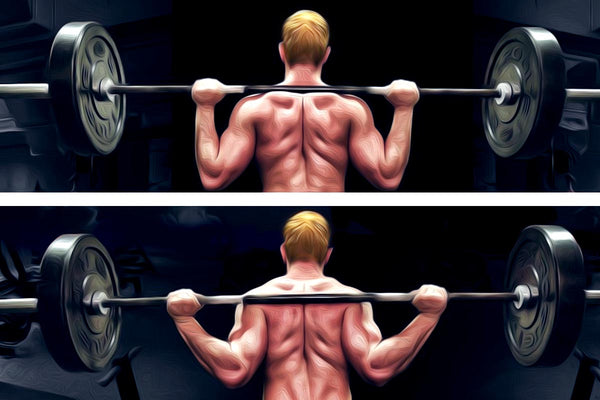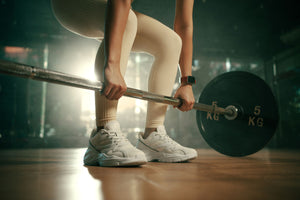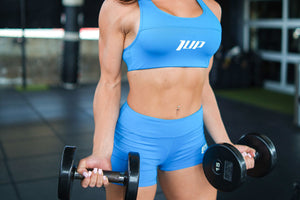The squat is known far and wide as one of the best exercises you can do to build muscle and strength. And, there’s almost endless variations of the squat that you can perform -- back squats, front squats, split squats, goblet squat, and even zercher squats.
One of the most frequently debated topics in fitness is which way a person should perform the back squat -- high bar or low bar.
In this article we’ll explain the differences between these two variations of the back squat and when you might want to use them in your training program.
The Difference Between High Bar Squats vs. Low Bar Squats
Right off the bat, a big difference between high bar squats and low bar squats is the position of the barbell on your back.
For high bar squats, the barbell is usually placed on top of the shoulders, just below the C-7 vertebrae. For low bar squats, the barbell is about 2-3 inches farther down your back.
Additionally, during low bar squatting the hands are placed several inches wider on the bar compared to their placement for high bar squats, and the elbows also tend to be flared. The reason for this is that the low bar placement forces the torso to lean a bit farther forward as you squat down to keep the bar path vertical.
This also means that your knees will not track forward as much as they do during high bar squatting.
While these differences might seem rather small in the grand scheme of things, this slight difference in bar placement generates quite the commotion among more hardcore gym rats, generally in regards to one style being “better” than the other.
Truth be told, both high bar squats and low bar squats can be effective for helping you in your body transformation to build toner legs and firmer glutes.
But, deciding which style of back squat is “right” for you also depends on a number of other factors (many of which we’ll discuss in a moment).
Last, but certainly not least, an individual can usually squat 5-10% more weight squatting with a low bar placement than a high bar one. This is due to the favorable leverage you achieve when using the low bar positioning.
However, just because you can move more weight with the low bar squat that doesn’t necessarily mean your muscles are necessarily working harder than they are compared to a high bar squat, or that you’re creating more tension in them (tension being the primary driver of muscle growth).
With low bar squats, you’ve put your body in a more favorable (efficient) position to lift the weight, which means you would have to use more weight to induce the same level of tension in the thighs compared to what you could induce using a lower weight with high bar squats.
How Do I Know Which Style is Right for Me?
The answer to this question will depend on several factors such as your individual anatomy, biomechanics, training goals and personal preferences.
If your goal is to simply improve your body composition and build stronger, firmer thighs and glutes, then you can choose to perform either high bar or low bar squats. Both are effective in training the quadriceps and glutes and both can be used in your training. Depending on the length of your femurs and individual hip anatomy, high bar squats may feel better or low bar squats may feel better.
Experiment with one style for a couple of weeks, and then try the other for a few weeks and see which one jives better with your anatomy and biomechanics. Generally speaking, we’re inclined to lean more towards the high bar squat for pure muscle-building as it has a slightly longer range of motion, which increases the time under tension on the leg muscles, which means they have to work harder.
Now, if your goal is to compete in powerlifting or strongman, you will want to perform low bar squats almost exclusively when preparing for competition. Remember, the goal in powerlifting is to move a maximal amount of weight. Seeing as low bar squats advantage you to move the most weight possible, it makes sense that squatting low bar is the style you should in which you should become proficient.
If you’re a powerlifter, but not 1-2 months out from a meet, then you may perform whichever style you like, but the closer you get to competition, the more you need to prioritize low bar squats in your training.
Finally, if you are an Olympic weightlifter, CrossFit athlete, or any other type of field sport athlete, you will want to focus on high bar squatting. The reason for this is that high bar squats are performed with a more upright torso which will have greater transfer to heavy cleans and snatches used in weightlifting competitions.
Additionally, the high bar squat allows an athlete to train in a similar torso, hip, knee, and ankle position that mimics the athletic stance used as a starting position in many sports. High bar squats will strengthen an athlete in their natural athletic stance and make them stronger when they’re moving through it (such as an offensive lineman driving through another defensive lineman in football).
The Bottom Line on High Bar vs Low Bar Squats
The biggest difference between high bar and low bar squats is the placement of the bar on your back. The low bar squat allows you to move more weight, but that doesn’t necessarily mean it works the muscles of the upper leg harder than the high bar squat, or that it is superior for building muscle.
Ultimately, your training goals will dictate which style of squatting is best for you. If you are a powerlifter or strongman athlete, you should prioritize low bar squatting in your training. If you are training for any other sport or just looking to improve overall body composition (build muscle and lose fat), high bar squatting is probably the way to go.






